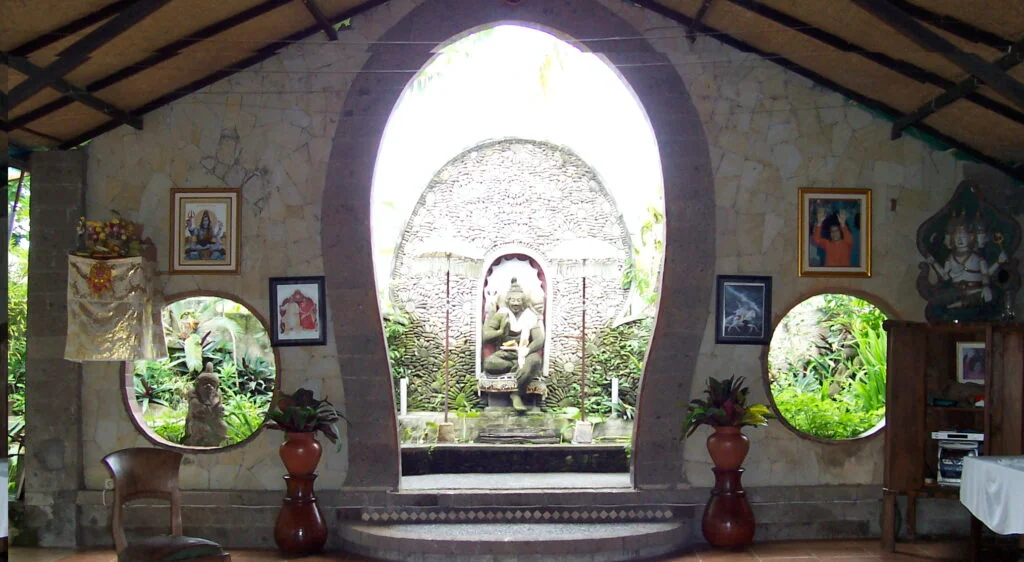Indonesia
Ria’s Personal & Professional Experience
Indonesia, my personal & professional Journey
Indonesia holds a very special place in my heart, both personally and professionally. While my family is Dutch-Indonesian, and many aspects of the culture, customs, and beliefs were a part of our daily lives, I never truly understood Indonesia itself until I visited for work. My first trip there was unforgettable and remains special to this day. It allowed me to experience and understand many things that had always seemed familiar yet lacked context. Finally, the pieces of the puzzle fell into place, and my heart felt complete!
Indonesia is a beautiful and diverse country in Southeast Asia, made up of thousands of islands and a rich blend of cultures, languages, and traditions. Known for its stunning landscapes, from lush rainforests to pristine beaches and active volcanoes, Indonesia is a place of incredible natural beauty. Its history, influenced by a mix of indigenous cultures and foreign influences, creates a unique and vibrant atmosphere. Whether it’s the delicious food, the warmth of the people, or the deep cultural heritage, Indonesia is a country that captures the hearts of those who experience it., including me!! So let me share my precious professional and personal moments & memories with you right here:

In my role as International Relations Officer and coordinator of a Master of Public Health Program, I was responsible for fostering strong collaborations between the university I worked for. Indonesia was one of the 52 different countries, embassies and universities that I worked with. One of my key tasks was to provide Dutch scholarships to outstanding students. I conducted interviews at the “Holland Education Fairs,” screened and certified students applications, and was able to recruit them on the spot during our personal meetings, which enabled them to apply for scholarships immediately. Our University alumni, who became lifelong friends during their studies in the Netherlands, continued to assist and collaborate with us during the HEF Fairs. It was an incredibly rewarding and enjoyable experience every time, especially while being successful in my beloved Indonesia.
Precious moments and memories to share with you;
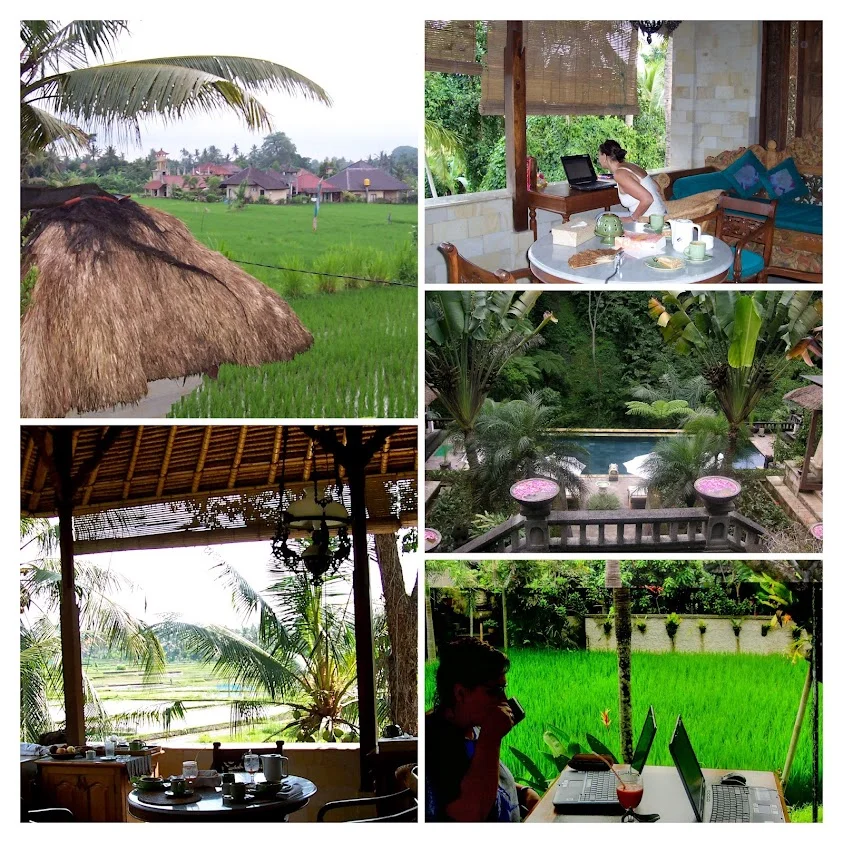
Our Ubud Office:
After the busy time in Jakarta and Yogyakarta, me and my friend and colleague Monique, who lived in Jakarta, occasionally went on a “field trip”. While staying in the Ubud area, it was a real privilege to do what we needed to do remotely, something not so usual years before Covid hit but call us “pioneers”. It wasn’t only the wonderful times we shared during or work trips in Indonesia but also the very rewarding outcomes. I especially remember the time that we went straight to Bandah Aceh after the Tsunami hit that region so hard.
Bandah Aceh after the devastating Tsunami
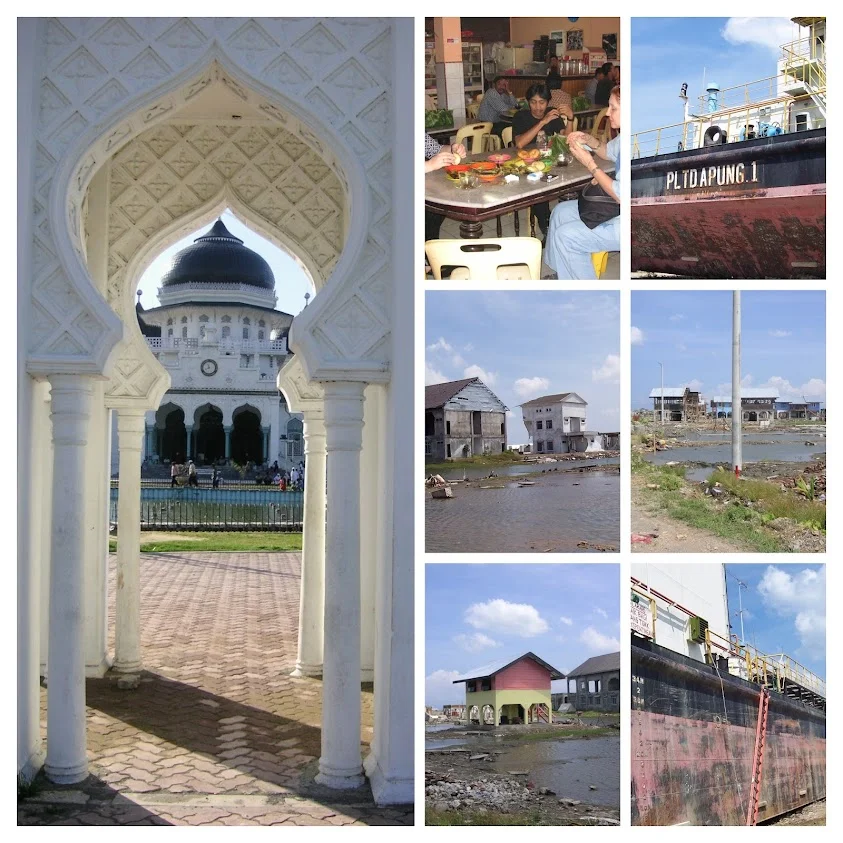
During our annual HEF education fair in Jakarta our main topic was the devastating Bandah Aceh tsunami and we were brainstorming what we could do to provide our help and support, even on a small scale.
We boarded a plane that was packed with NGO staff, officials, volunteers, lots of rice and other food supplies, sewing machines, and much much more. There was a mix of grief and gratitude in the air, and despite the extensive destruction, the good news was that the Temple’s roof saved so many lives when people climbed up there last minute. Rebuilding is a lengthy process, but it was truly heartwarming to witness the support and assistance, locally, nationally, and internationally.
My Favorite Travel Part in Indonesia is West Bali & Ubud
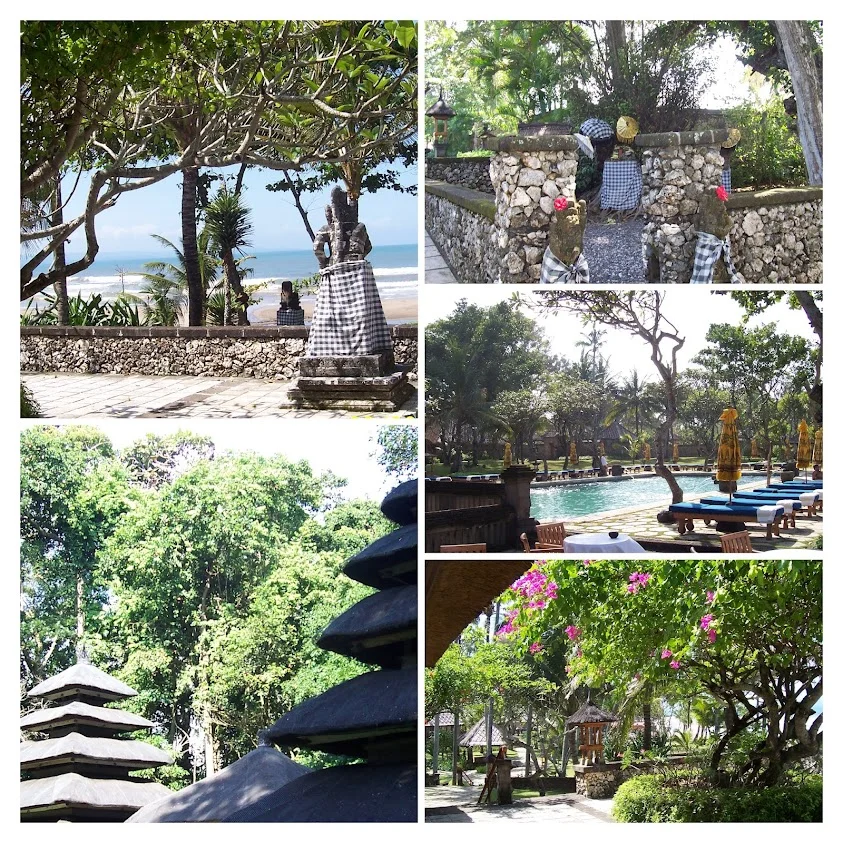
Bali, often referred to as the “Island of the Gods,” is one of Indonesia’s most famous and beloved destinations. Known for its stunning beaches, vibrant culture, and lush landscapes, Bali offers something for everyone, from relaxing beachfront resorts to adventure-filled hikes and cultural experiences.
The island is a mix of traditional Balinese culture and modern tourism, with picturesque temples like Tanah Lot and Uluwatu offering spiritual experiences. Ubud, in the heart of Bali, is a hub for arts, wellness, and natural beauty, while places like Seminyak and Kuta are known for their lively atmosphere, luxury resorts, and surfing spots.
Bali’s cuisine, with its fresh ingredients and bold flavors, is another highlight, and the island’s people are known for their warm hospitality. Whether you’re interested in yoga, exploring rice terraces, or immersing yourself in local traditions, Bali offers an unforgettable experience.
Indonesian higher education is diverse and evolving, with a wide range of institutions offering programs across various disciplines. The system is made up of public and private universities, along with polytechnics and vocational institutions, providing options for both academic and applied learning.
Batik and Woodcarving Art
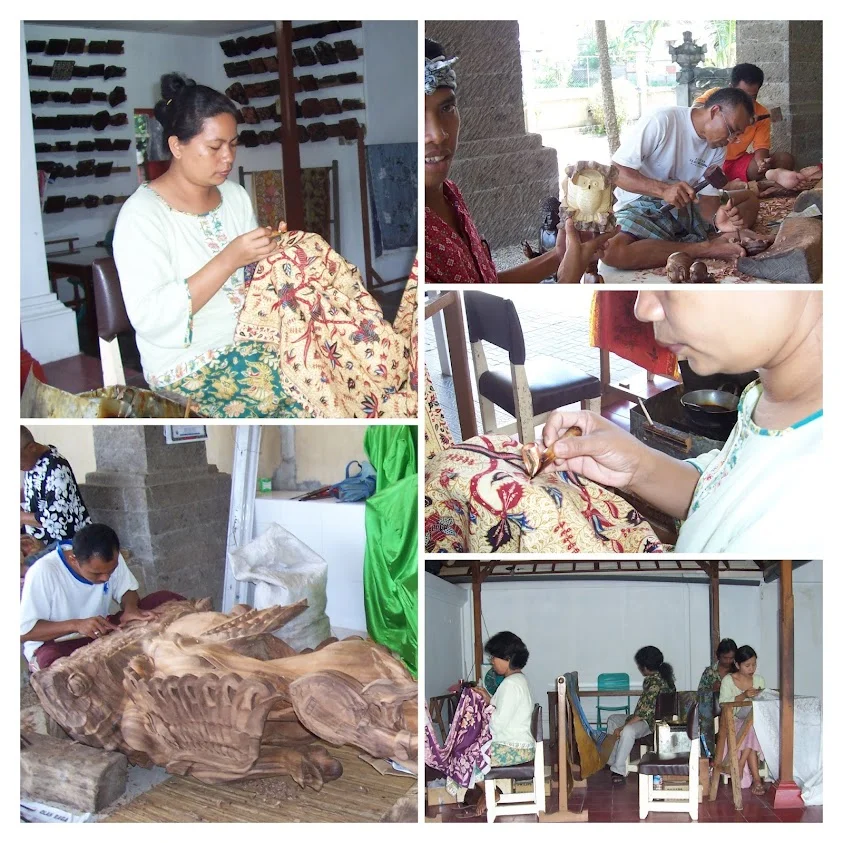
Indonesia, and especially Bali, is renowned for its rich and diverse artistic traditions, which are deeply rooted in cultural heritage, spirituality, and craftsmanship. Two significant forms of art in Bali and throughout Indonesia are batik and wood carving, both of which are highly valued for their intricate beauty and the skills involved in creating them.
Bali and Indonesian Arts Overview
Bali is famous for its vibrant arts scene, which includes painting, sculpture, dance, music, and textile arts. The island has long been a center for traditional and contemporary arts, with influences from Hindu-Buddhist culture, local traditions, and foreign exchanges, especially during Bali’s historical trade connections. Art plays an essential role in religious ceremonies, temple offerings, and daily life, reflecting the island’s deep connection to spirituality.
Batik Art
Batik is a traditional fabric-dyeing technique that originated in Java but has spread throughout Indonesia, with Bali offering its unique take on the art. The word “batik” comes from the Javanese word “ambatik,” which means “a cloth with a wax-resist design.”
Process:
- Wax Resist Dyeing: The batik process involves applying wax onto the fabric (usually cotton or silk) in intricate patterns using a tool called a “canting” (for smaller details) or a “cap” (for larger designs). The areas with wax resist the dye, creating a unique pattern.
- Dyeing: After the wax is applied, the fabric is dyed in multiple colors. The process is repeated for each layer of color, with the wax protecting certain areas from each subsequent dyeing step.
- Finishing: After the dyeing process is completed, the fabric is boiled to remove the wax, leaving the vibrant patterns behind.
Patterns and Symbolism:
- Nature-inspired: Bali’s batik designs often reflect the island’s rich natural environment, including motifs like flowers, animals, and traditional symbols.
- Spirituality: Some batik patterns are linked to Bali’s religious beliefs, with motifs symbolizing gods, spirits, or sacred objects.
- Local Influence: While batik in Java tends to focus on more geometric and symmetrical designs, Balinese batik incorporates more fluid, organic patterns that reflect the island’s cultural vibrancy.
Batik is not just clothing; it is also used for various decorative items like tablecloths, wall hangings, and sarongs, making it an important aspect of both traditional and contemporary Balinese culture.
Woodcarving
Woodcarving in Bali is one of the most notable and respected art forms, with deep cultural roots and a rich history that stretches back centuries. Balinese woodcarving is known for its detailed and intricate craftsmanship, often representing mythological, religious, and cultural themes.
Process:
- Selecting the Wood: Traditionally, carvers use softwoods like wood from the jackfruit tree, though harder woods are also used for durability. The wood is selected for its texture, grain, and ability to hold intricate detail.
- Design and Carving: The artist begins by sketching a design, often inspired by Balinese mythology, Hindu-Buddhist religion, and nature. The carving is done by hand using sharp tools to achieve high levels of detail and depth.
- Finishing: Once the carving is complete, the piece is sanded down, smoothed, and sometimes painted. Traditional woodcarvings may be left natural or stained, while others are decorated with vivid colors and gold leaf for temple or ceremonial use.
Styles of Woodcarving:
- Religious Themes: Many woodcarvings depict deities, mythological figures, or scenes from Hindu epics like the Ramayana and Mahabharata. These carvings are often displayed in temples or shrines.
- Animal and Nature Motifs: Balinese woodcarvings often feature motifs inspired by nature, such as birds, trees, and flowers. The detailing can be incredibly intricate, with layered textures and elaborate designs.
- Decorative Arts: Woodcarving is also used for creating furniture, doors, window frames, and decorative panels for homes and temples, contributing to the overall aesthetic of Balinese architecture.
Cultural Significance:
Woodcarving is not only an art form but also a reflection of Balinese culture and spirituality. The intricate carvings are often seen as expressions of devotion to the gods, and the process of creating these works is considered sacred. Many families in Bali have passed down woodcarving skills for generations, maintaining a strong tradition of craftsmanship.
Batik and Woodcarving in Modern Bali
Today, both batik and woodcarving are popular with tourists and collectors. In addition to traditional methods, contemporary artists are experimenting with these mediums, bringing new interpretations and innovative designs while still honoring the heritage.
- Batik: While traditional batik designs remain popular, modern designers in Bali and beyond are incorporating contemporary themes and global fashion trends into their batik creations, allowing for fusion styles that appeal to both local and international markets.
- Woodcarving: In recent years, Bali has seen a rise in demand for modern wooden sculptures, furniture, and decorative arts. These often blend traditional carving techniques with a more minimalist or contemporary style.
Both art forms also play an essential role in Bali’s tourism industry, with local artisans selling their work in markets and galleries throughout the island. Visitors to Bali often have the opportunity to observe artisans at work, which further strengthens the island’s reputation as an arts hub.
Where to See Batik and Woodcarving in Bali
- Ubud: Known as Bali’s cultural heart, Ubud is home to many galleries and shops that feature batik textiles and woodcarvings. You can also visit the Ubud Art Market and explore workshops where you can watch artisans at work.
- Celuk Village: Famous for gold and silver jewelry, Celuk also has workshops where woodcarving and other traditional crafts can be seen up close.
- Mas Village: This village is renowned for its exceptional woodcarving, and you can find intricate pieces in galleries throughout the area.
Bali’s batik and woodcarving represent just two of the many aspects of its rich cultural heritage, showcasing the skill and creativity of the artisans who call this island home.
Bali, often referred to as the “Island of the Gods,” is not only known for its rich culture, vibrant arts, and stunning landscapes but also for its diverse wildlife and thriving tourism industry. Whether you’re seeking adventure, nature, or relaxation, Bali offers an abundance of experiences for travelers of
Tourism on Bali Island
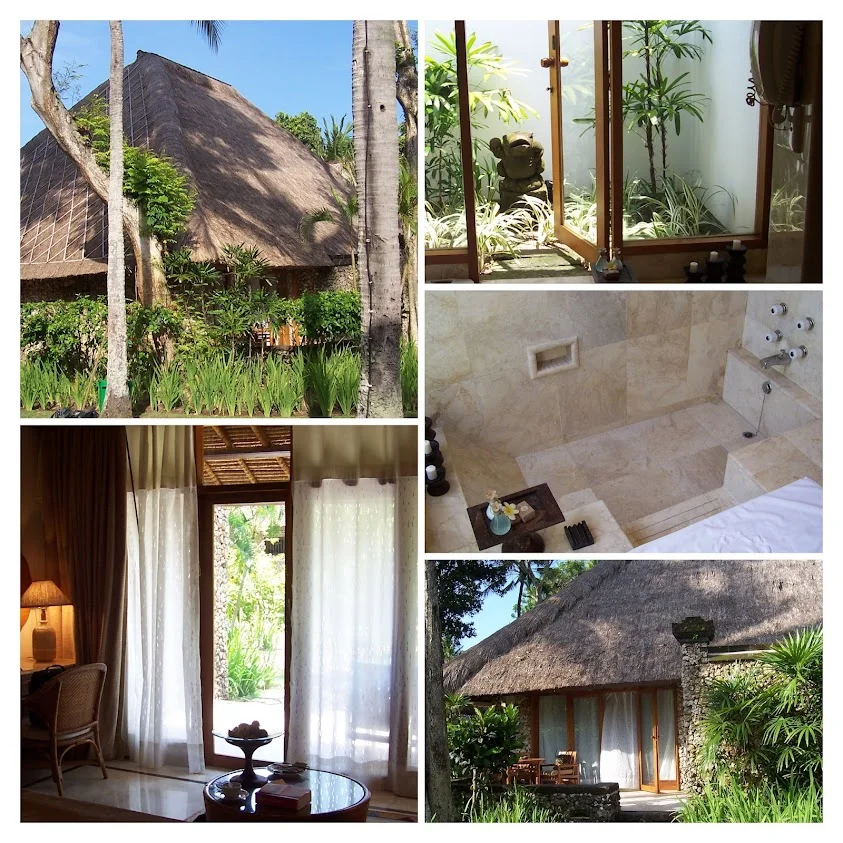
Bali is one of the world’s top tourist destinations, attracting millions of visitors each year due to its unique blend of cultural richness, natural beauty, and modern amenities. The island offers a variety of experiences ranging from beach vacations and luxury resorts to cultural immersion and eco-tourism.
Beaches, Coastal Areas, Shopping & Nightlife
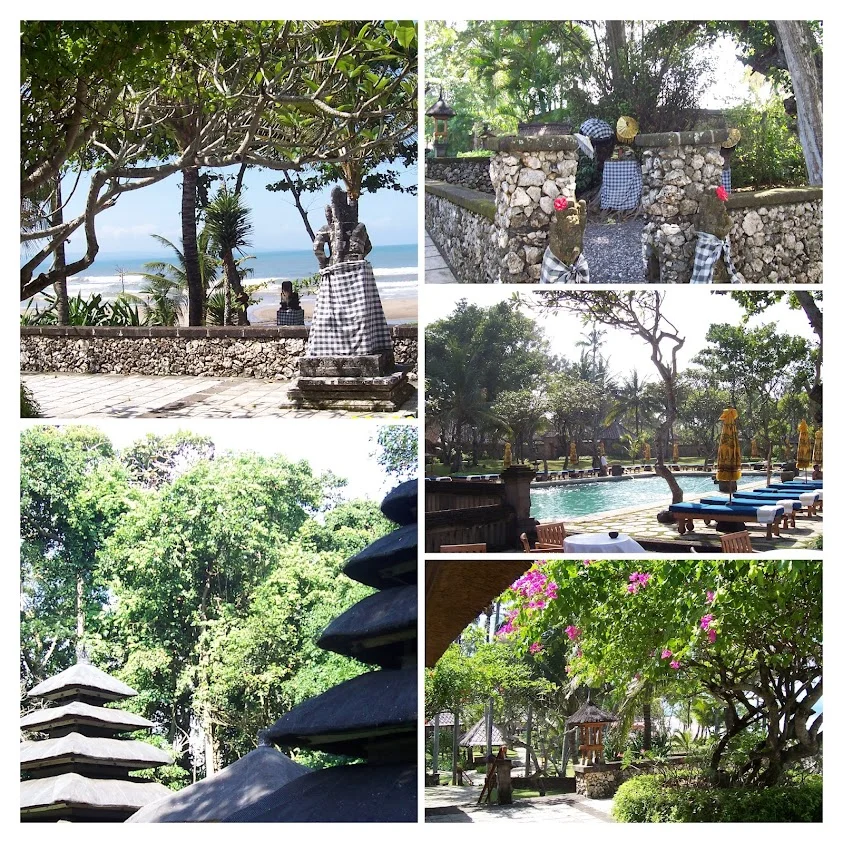
- Beaches and Coastal Areas:
- Kuta: Known for its lively atmosphere and great surf, Kuta is one of Bali’s most famous beaches. It’s popular among tourists for its bars, restaurants, and nightclubs.
- Seminyak and Canggu: These areas are more upscale and are home to trendy boutiques, high-end resorts, and stylish cafes. Seminyak Beach offers beautiful sunsets.
- Jimbaran: Known for its seafood dining on the beach and calm waters, Jimbaran is perfect for a more relaxed beach experience.
- Nusa Dua: Famous for its luxury resorts, calm beaches, and beautiful resorts, Nusa Dua is great for family holidays and beach lovers.
- Shopping and Nightlife:
- Ubud Art Market: The bustling market in Ubud is a great place to shop for handmade crafts, clothes, paintings, and souvenirs that reflect Bali’s cultural artistry.
- Seminyak’s Shopping Scene: Seminyak has many high-end boutiques offering fashion, home décor, and unique jewelry.
- Nightlife: Bali’s nightlife is diverse, ranging from beach clubs like Potato Head Beach Club in Seminyak to bars and nightclubs in Kuta and Ubud, making it ideal for those looking for both relaxed evenings and vibrant nightlife.
Tanah Lot Temple
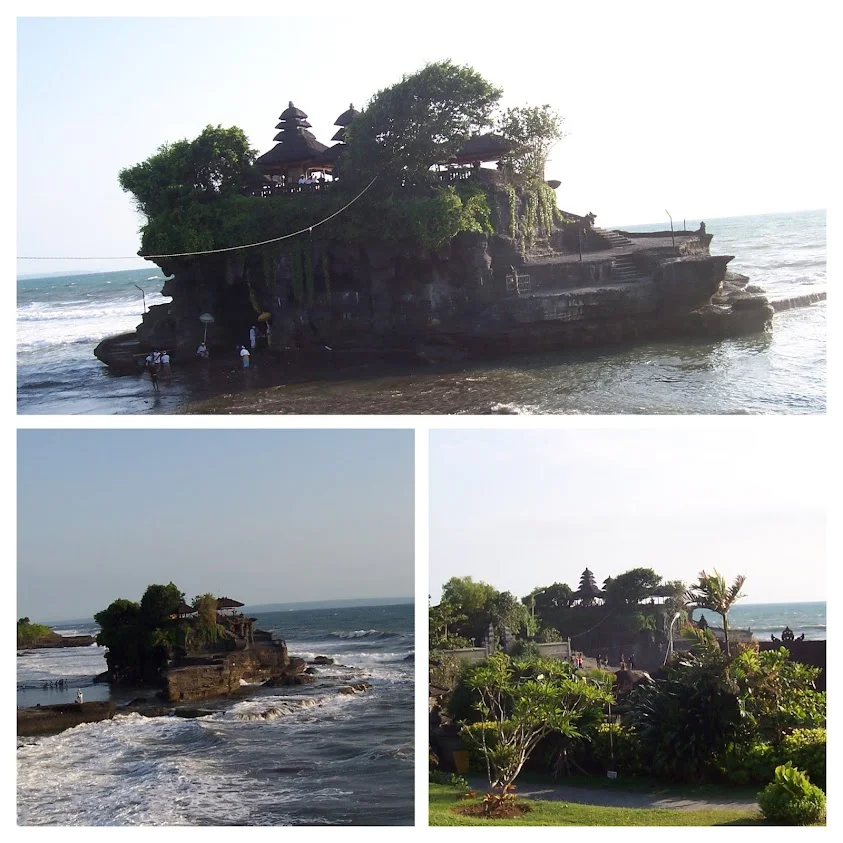
Tanah Lot Temple is one of Bali’s most iconic landmarks and a must-visit destination for those exploring the island. Located on the southwest coast of Bali, Tanah Lot is a Hindu sea temple perched on a rocky outcrop in the Indian Ocean, offering one of the most stunning scenic views on the island. The name “Tanah Lot” comes from the Balinese words “Tanah” (meaning “land”) and “Lot” (meaning “sea”), which together refer to the temple’s dramatic location, standing against the backdrop of the sea.
History and Significance:
Tanah Lot Temple holds deep cultural and spiritual significance for the Balinese people. It is dedicated to the sea gods and has been an important pilgrimage site for centuries. According to Balinese legend, the temple was founded by the 16th-century Hindu priest Dang Hyang Nirartha, who was traveling through Bali when he stopped at the site. He was captivated by the location and decided to establish the temple as a place of worship for the gods of the sea. The temple is thought to be one of the seven sea temples along Bali’s southern coast, which were built to honor the ocean and protect the island from evil spirits.
The temple is an important part of Bali’s cultural heritage, as it symbolizes the island’s connection to both the natural world and the spiritual realm. It is particularly famous for being a place of offering and prayer, especially during ceremonial events, when devotees gather to pay respects to the sea gods.
The Temple Structure:
Tanah Lot Temple is relatively small but holds great beauty and importance. The temple sits on a rock formation, which is only accessible by foot during low tide. The area around the temple is lined with picturesque rock formations and is surrounded by the vastness of the Indian Ocean. When the tide comes in, the temple is surrounded by water, making it look like it’s floating on the sea, creating an incredibly scenic and mystical atmosphere.
The temple itself is not open to the public to enter, as it is considered sacred, but visitors can admire it from the viewing platforms along the coastline or from the surrounding park area. There is also a smaller temple to the left of the main temple, which is believed to house a sacred spring, and it is said that local villagers use this water for healing purposes.
Best Time to Visit:
- Sunset: One of the best times to visit Tanah Lot is during the late afternoon, when the sun begins to set. The temple, with its dramatic backdrop, creates a magical setting for sunset photography. Visitors often gather along the shore to watch the sun dip below the horizon, casting vibrant colors across the sky.
- Low Tide: To visit the temple itself, you will need to go during low tide, when it’s possible to walk to the temple across the rocky shore. During high tide, the temple is surrounded by water and becomes inaccessible, but it still provides a breathtaking view from a distance.
Visiting Tanah Lot:
- Entry Fee: There is a small entrance fee to visit Tanah Lot, and it helps support the maintenance of the temple and surrounding area.
- Walkways and Viewing Areas: The temple is accessible via paved walkways that lead to viewing areas where you can enjoy panoramic views of the temple and the ocean. The area is well-developed, with shops, restaurants, and cultural performances in the vicinity.
- Temple Ceremonies: If you visit during a religious ceremony or festival, you may witness traditional Balinese offerings and rituals, providing an even deeper connection to the island’s culture and spirituality.
Cultural Significance:
Tanah Lot Temple is not only a breathtaking sight but also an essential part of Bali’s spiritual and religious life. Balinese Hindus believe that the temple protects the island from the wrath of the sea and evil spirits. It is also an important place for making offerings to the gods and seeking blessings for a prosperous life.
The temple is also a symbol of Bali’s rich cultural heritage, as it represents the island’s close relationship with nature and the belief that the divine can be found in both the natural world and everyday life.
Tips for Visiting:
- Arrive early or late: To avoid the crowds, consider visiting early in the morning or closer to sunset. The temple is particularly magical at sunset, but it can get quite busy.
- Dress modestly: As with all religious sites in Bali, it’s respectful to dress modestly when visiting the temple. A sarong (which is often provided) is required to enter temple grounds.
- Respect the sacred site: While Tanah Lot is a popular tourist spot, it remains a sacred place for the Balinese. Be mindful of local customs and avoid disturbing any religious ceremonies.
Tanah Lot Temple is truly a place of spiritual significance and one of the most stunning locations in Bali, combining natural beauty with cultural and religious depth. Whether you’re drawn to its tranquil beauty or its rich history, it offers an unforgettable experience.
Would you like tips on how to get there or additional
Rice Paddies, Terraces & Nature
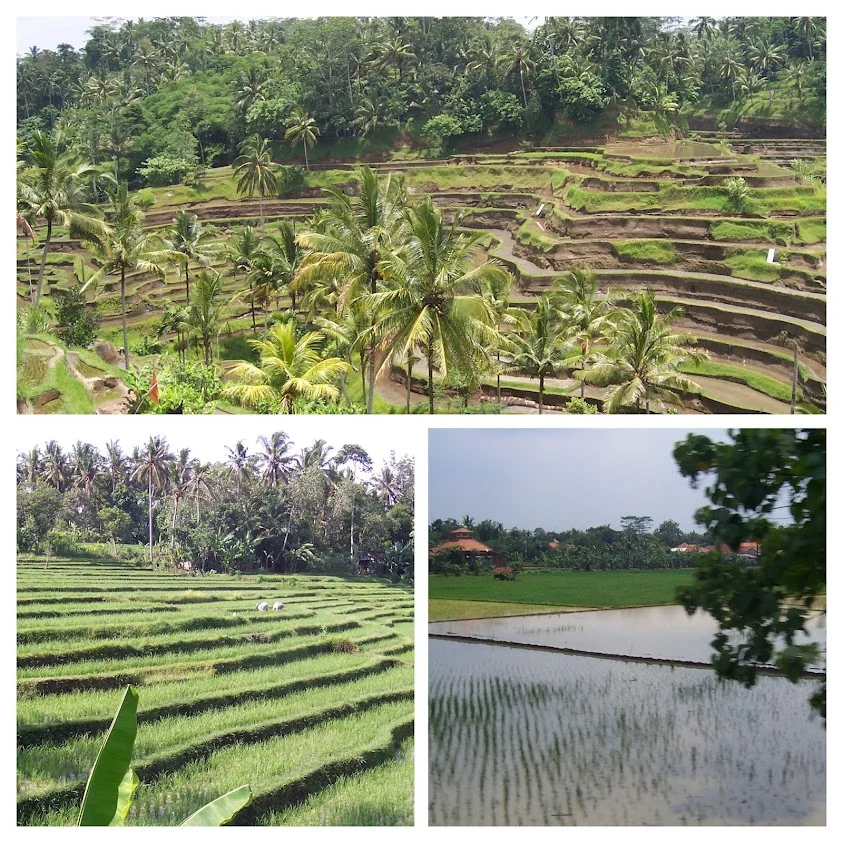
Tegallalang Rice Terraces: These stunning, terraced rice fields are an iconic part of Bali’s agricultural landscape. They offer a picture perfect picturesque experience.
Mount Batur: For adventure seekers, hiking up Mount Batur to watch the sunrise is a must-do activity. The active volcano offers an awe-inspiring view from the summit.
Sacred Monkey Forest Sanctuary: Located in Ubud, this lush, green sanctuary is home to hundreds of long-tailed macaques and provides a unique and peaceful walk through the forest.
Wildlife on Land
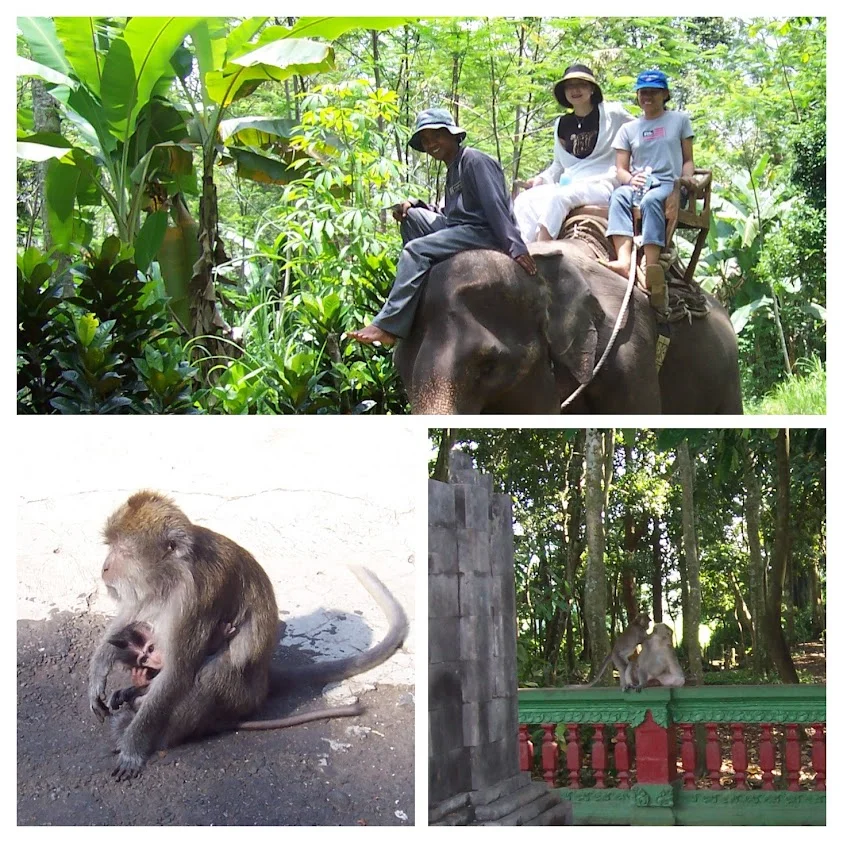
Bali is home to a wide range of flora and fauna, both on land and in the surrounding seas. Its tropical climate supports diverse ecosystems, from dense rainforests and rice terraces to coral reefs and marine life.
Bali’s Monkeys:
- Elephants: They are tame but still considered wild animals. You can choose to make a forest tour with the local Elephants and their care-givers
- Long-tailed Macaques: Found in places like the Sacred Monkey Forest Sanctuary in Ubud, these mischievous creatures are one of Bali’s most famous wildlife species. They live in social groups and are often seen interacting with tourists.
- Bali Starling (Leucopsar rothschildi): This critically endangered bird, also known as the Bali Myna, is native to the island and is often found in conservation areas like West Bali National Park. Conservation efforts are underway to protect this bird from extinction.
Bali’s Reptiles and Amphibians:
- Komodo Dragon: While not found directly in Bali, the Komodo Dragon can be seen on the nearby islands of Komodo and Rinca in the Komodo National Park, which is a short flight away. The Komodo Dragon is the world’s largest living lizard and is a fascinating creature to observe.
- Snakes and Frogs: Bali is home to various species of snakes, including the Bali pit viper, as well as amphibians like tree frogs and toads, particularly in the island’s forests and rice fields.
Bali’s balance of rich cultural heritage and stunning natural beauty makes it a remarkable destination for those seeking adventure, nature, and the chance to connect with the island’s wildlife.
The Borubudor is considered the most beautiful Ancient Temple in Central Java
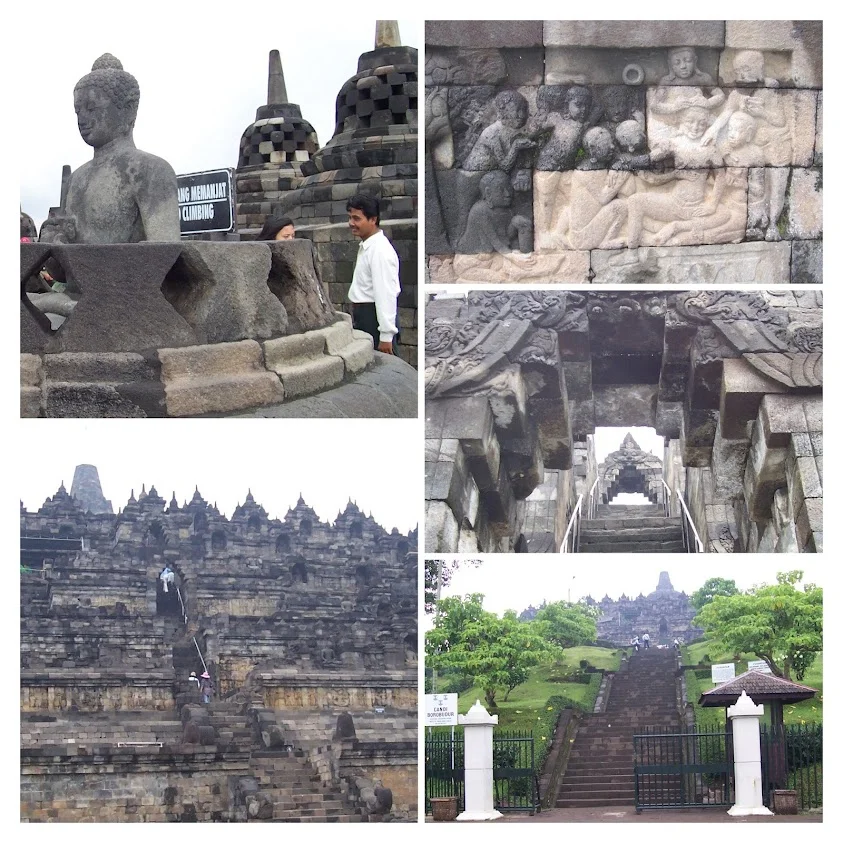
Borobudur is one of Indonesia’s most famous and awe-inspiring landmarks, and it is considered one of the greatest Buddhist monuments in the world. Located in Central Java, about 40 kilometers (25 miles) northwest of Yogyakarta, Borobudur is a massive and intricate temple complex that attracts visitors from all over the world for its historical, architectural, and spiritual significance.
History of Borobudur
Borobudur was built during the Syailendra Dynasty in the 9th century, around 780 to 840 AD, under the rule of King Samaratungga. It is believed to have taken several decades to complete and was constructed as a Mahayana Buddhist temple and pilgrimage site. The structure itself was abandoned by the 14th century due to the decline of the Hindu-Buddhist kingdoms in Java and the rise of Islam in the region. It remained hidden under layers of volcanic ash and jungle until it was rediscovered in the early 19th century by the British during the colonial era.
In 1991, Borobudur was designated a UNESCO World Heritage Site, in recognition of its cultural and historical importance. It is now one of the most visited tourist destinations in Indonesia.
Architectural Features
Borobudur is a massive, multi-tiered structure, and its design reflects Buddhist cosmology, with the monument symbolizing the journey from samsara (the cycle of birth, death, and rebirth) to nirvana (enlightenment and liberation from suffering).
- Levels:
- Base (Lower Levels): The lower levels of Borobudur represent the world of desire (Kama), where human beings are still bound by the material world. It has intricate carvings depicting various scenes from the life of the Buddha and the Jataka tales, illustrating his previous lives and lessons for overcoming earthly desires.
- Middle Levels: These represent the world of forms (Rupa), where one begins the journey toward spiritual purification. The middle levels feature more complex carvings of Buddhist teachings and parables.
- Upper Levels: The top levels represent the world of formlessness (Arupa) and symbolize the path to enlightenment and nirvana. These levels feature 72 small stupas, each housing a statue of the Buddha, arranged in a circular fashion. The central stupa at the very top of the monument represents the ultimate state of nirvana.
- The Central Stupa: The large central stupa, located at the top of the monument, is the highest point and serves as the symbol of enlightenment. It is surrounded by 72 smaller stupas, each containing a Buddha statue. These stupas are open on the sides, allowing visitors to peer inside at the serene Buddha figures.
- Carvings and Reliefs: Borobudur is adorned with more than 2,600 relief panels and 504 Buddha statues. These carvings depict a wide range of Buddhist teachings, including stories of the Buddha’s life, his teachings on morality, and Buddhist cosmology. The reliefs on the lower levels focus on the Buddha’s life, while the upper levels emphasize the path to spiritual enlightenment.
- Mandala Design: The temple is constructed in the shape of a mandala, symbolizing the universe in its entirety. This intricate design represents the Buddhist concept of the universe, with the temple serving as a microcosm of the world and the journey toward spiritual awakening.
Spiritual and Cultural Significance
Borobudur is not just an architectural marvel; it is also a deeply spiritual place. As a pilgrimage site, the temple was designed for worshippers to physically and metaphorically walk the path toward enlightenment. Pilgrims would ascend the temple’s tiers, stopping at each level to meditate on the carvings and reflect on the teachings of the Buddha.
The monument is also closely tied to the Buddhist teachings of the Mahayana tradition, which emphasizes compassion for all beings and the pursuit of enlightenment. The reliefs on the temple walls depict various stages of the Buddha’s life, illustrating lessons on ethics, morality, and the steps needed to achieve nirvana.
Visiting Borobudur
- Best Time to Visit:
- Sunrise: For a truly magical experience, many visitors come to Borobudur early in the morning to watch the sunrise. The temple is usually less crowded at this time, and the view of the sun rising over the monument and the surrounding plains is breathtaking.
- Sunset: Visiting in the late afternoon or at sunset is also a great way to enjoy the temple’s beauty while avoiding the midday heat and crowds.
- Admission Fees:
- Borobudur has an entrance fee, and there are various ticket options, including packages that include guided tours. It’s recommended to check the official website for updated pricing and booking information.
- Climbing Borobudur:
- Visitors are allowed to climb the temple’s levels, though it’s important to respect the site’s sacredness. The steps can be quite steep, so it’s advisable to wear comfortable shoes and bring plenty of water, especially if visiting during the warmer months.
- Nearby Attractions:
- Mendut Temple: Located about 3 kilometers from Borobudur, Mendut Temple is another Buddhist temple that is often visited in conjunction with Borobudur. It features a large statue of the Buddha and is home to intricate relief carvings.
- Pawon Temple: Another nearby temple located between Borobudur and Mendut, this small temple is dedicated to the ancestors of the Syailendra Dynasty.
- Cultural and Religious Events:
- Vesak (Waisak): Vesak is the most important Buddhist festival, which celebrates the birth, enlightenment, and death of the Buddha. During this time, a large procession takes place, and many people gather at Borobudur to celebrate with prayers, offerings, and ceremonies.
Some Fun Facts - Time & Traffic

When it comes to making appointments, whether for business or leisure, time is not so important in their lives. No matter what kind of transport is used, you have to be patient and open-minded. The only excuses everybody uses (even on a quiet part of the Islands is “Traffic Jam” <:) and I love their relaxing, friendly and easy going attitude and lifestyle.
Thank you for reading my Indonesian Blog, the story of my personal and professional life related to beautiful Indonesia and so close to my heart.
